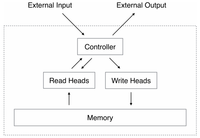2014 NeuralTuringMachines
- (Graves et al., 2014) ⇒ Alex Graves, Greg Wayne, and Ivo Danihelka. (2014). “Neural Turing Machines.” In: arXiv preprint arXiv:1410.5401.
Subject Headings: Neural Turing Machine.
Notes
Cited By
Quotes
Abstract
We extend the capabilities of neural networks by coupling them to external memory resources, which they can interact with by attentional processes. The combined system is analogous to a Turing Machine or Von Neumann architecture but is differentiable end-to-end, allowing it to be efficiently trained with gradient descent. Preliminary results demonstrate that Neural Turing Machines can infer simple algorithms such as copying, sorting, and associative recall from input and output examples.
1 Introduction
Computer programs make use of three fundamental mechanisms: elementary operations (e.g., arithmetic operations), logical flow control (branching), and external memory, which can be written to and read from in the course of computation (Von Neumann, 1945). Despite its wide-ranging success in modelling complicated data, modern machine learning has largely neglected the use of logical flow control and external memory. Recurrent neural networks (RNNs) stand out from other machine learning methods for their ability to learn and carry out complicated transformations of data over extended periods of time. Moreover, it is known that RNNs are Turing-Complete (Siegelmann and Sontag, 1995), and therefore have the capacity to simulate arbitrary procedures, if properly wired. Yet what is possible in principle is not always what is simple in practice. We therefore enrich the capabilities of standard recurrent networks to simplify the solution of algorithmic tasks. This enrichment is primarily via a large, addressable memory, so, by analogy to Turing's enrichment of finite-state machines by an infinite memory tape, we
Figures
References
;
| Author | volume | Date Value | title | type | journal | titleUrl | doi | note | year | |
|---|---|---|---|---|---|---|---|---|---|---|
| 2014 NeuralTuringMachines | Alex Graves Greg Wayne Ivo Danihelka | Neural Turing Machines | 2014 |
